Salvatore Fiume biography

Salvatore Fiume was an Italian painter and sculptor. He was born in Comiso, in the province of Ragusa, in 1915. At sixteen, he won a scholarship to the Royal Institute for Book Illustration of Urbino where he learned printing techniques: lithography, screenprint, etching, and woodcut. After finishing his studies, he moved to Milan where he met and socialized with artists such as Dino Buzzati, Salvatore Quasimodo and Raffaele Carrieri.
After a brief experience at Olivetti as art director of the company magazine, he moves to Canzo in the province of Como to dedicate himself entirely to painting. Here he buys and renovates a huge nineteenth-century silk mill to adapt it as a studio, which today is the seat of the Salvatore Fiume Foundation.
His first solo exhibition is held at the Galleria Borromini in Milan in 1949. The exhibition is a great critical success so much so that Alfred H. Barr Jr., director of the MoMA, Museum of Modern Art in New York, purchases the City of Statues from 1947 which is still kept there today. In the same year he also takes part in the exhibition Twentieth-Century Italian Art held again at the MoMA. The following year he is invited to the Venice Biennale where he exhibits the triptych Island of Statues which is now part of the collection of Modern and Contemporary Art of the Vatican Museums.
A period of important commissions begins including that of the architect Gio Ponti in 1951 for a huge painting to be displayed in the first-class lounge of the transatlantic Andrea Doria, that of the magazines Life and Time for a series of works depicting an imaginary story of Manhattan and New York Bay, and that of Bruno Buitoni Sr for a cycle of ten large paintings on the theme of the Adventures, misfortunes and glories of the ancient Region of Umbria, from which Salvatore Fiume's interest in Renaissance painting is evident.
Between 1962 and 1997 Salvatore Fiume begins a phase of travels and exhibitions around the world that greatly enrich his artistic personality.
In 1962 a traveling exhibition is organized with more than one hundred paintings by the painter that will be hosted in various German museums including those in the cities of Cologne and Regensburg.
In 1973, accompanied by his friend the photographer Walter Mori, Salvatore Fiume goes to Ethiopia, in the Babile valley, where he paints his Islands on a group of rocks using marine paints.
1974 is the time of the great retrospective exhibition at Palazzo Reale di Milano on the occasion of which Salvatore Fiume creates a life-size polystyrene reproduction of part of the painted rocks in Ethiopia, occupying almost entirely the huge Sala delle Cariatidi. On the same occasion he presents for the first time the African Mona Lisa, now kept in the Vatican Museums.
In 1993 the painter visits the places of Paul Gauguin in Polynesia and, in tribute to the great French master, donates a painting to the Museo Gauguin di Papeari a Tahiti. Salvatore Fiume dies in Milan in 1997.



